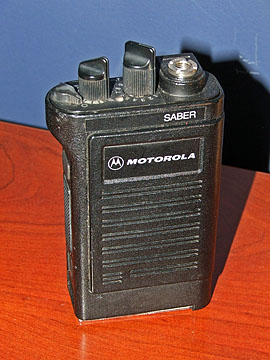Difference between revisions of "Saber I"
From The RadioReference Wiki
(Start the page off right...) |
m (Fix XTS link) |
||
| Line 1: | Line 1: | ||
[[Image:Saber1-front.jpg|thumb|Motorola Saber I Front (without battery or antenna)]] | [[Image:Saber1-front.jpg|thumb|Motorola Saber I Front (without battery or antenna)]] | ||
| − | The '''Motorola Saber I''' is a 12-channel handheld radio. It represented the 'base model' of the Saber line, which is no longer produced or supported by Motorola but continues to be popular in the ham and hobbyist market, especially as many public safety users phase them out in favor of the [[Motorola | + | The '''Motorola Saber I''' is a 12-channel handheld radio. It represented the 'base model' of the Saber line, which is no longer produced or supported by Motorola but continues to be popular in the ham and hobbyist market, especially as many public safety users phase them out, often in favor of the [[Motorola XTS Series]]. |
== Features == | == Features == | ||
Revision as of 21:25, 29 April 2007
The Motorola Saber I is a 12-channel handheld radio. It represented the 'base model' of the Saber line, which is no longer produced or supported by Motorola but continues to be popular in the ham and hobbyist market, especially as many public safety users phase them out, often in favor of the Motorola XTS Series.
Features
Features varied with time, but the following should be a good approximation:
- 12 channels
- Voice encryption (e.g., DES) capability (in some models)
- MDC1200 support (as well as the older MDC600)
- No scan capabilities on the Saber I (Saber II and III do support scan)
- No trunking capabilities (Systems Sabers do support trunking)
Securenet
Some (arguably, most) Sabers were Securenet-capable. These radios can be identified by:
- Model numbers with an "X" as the fifth character (e.g., H43QXN7139CN)
- Longer height (the area just below the speaker houses the secure module)
- A rocker switch to the left of the volume knob
- "SECURENET" or similar verbiage on the top of the radio
Bands
The Saber supported three main bands. While the band can be determined from the model number, the sub-bandsplit cannot. (E.g., it is possible to tell whether a radio is VHF or UHF, but it is not possible to tell what split within the band it covers.)
- VHF Low: 66-88 MHz (H42... model numbers)
- VHF (H43... model numbers)
- UHF (H44... model numbers)
